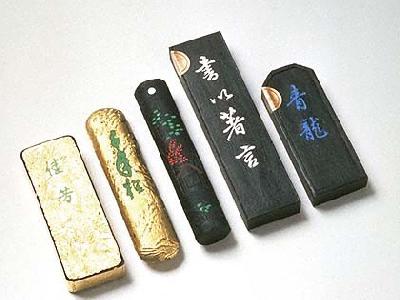|
Shiunseki Suzuri or Shiunseki Inkstone is an inkstone produced in Ichinoseki City and Oofunado City of Iwate Prefecture and is made from stone called Shiunseki that has a distinctive texture.
The origin of the inkstone dates back to Kamakura period when a monk who, on his travels, dropped by Chouan-ji Temple in Oofunado City and found a shiunseki stone at the bottom of a nearby river and used the stone as an inkstone. The monk later took the stone back to Kamakura and dedicated it to a Shogun at that time. With its beautiful looks, the inkstone was named Shiunseki (purple cloud) Inkstone.
Shiunseki stone is a schalstein extracted from soil more than 400 million years old from Kitakami mountain. The stone has a red-purplish color similar to azuki red beans. Also many of them have characteristic cloud-shaped patterns or greenish spots.
In addition to elegance and smoothness, the surface of the stone has fine and minute imperfections that allow ink-cake to be ground finely. These characteristics make Shiunseki stone the most suitable stone for inkstone.
There was a time when mass production of machine made inkstone was widespread and handmade Shiunseki Inkstone making waned. However, after World War II, artisans began turning their attention back to the craft of hand making the stone. Shiunseki Inkstone is still now being produced with the same quality as its legend suggests.
The origin of the inkstone dates back to Kamakura period when a monk who, on his travels, dropped by Chouan-ji Temple in Oofunado City and found a shiunseki stone at the bottom of a nearby river and used the stone as an inkstone. The monk later took the stone back to Kamakura and dedicated it to a Shogun at that time. With its beautiful looks, the inkstone was named Shiunseki (purple cloud) Inkstone.
Shiunseki stone is a schalstein extracted from soil more than 400 million years old from Kitakami mountain. The stone has a red-purplish color similar to azuki red beans. Also many of them have characteristic cloud-shaped patterns or greenish spots.
In addition to elegance and smoothness, the surface of the stone has fine and minute imperfections that allow ink-cake to be ground finely. These characteristics make Shiunseki stone the most suitable stone for inkstone.
There was a time when mass production of machine made inkstone was widespread and handmade Shiunseki Inkstone making waned. However, after World War II, artisans began turning their attention back to the craft of hand making the stone. Shiunseki Inkstone is still now being produced with the same quality as its legend suggests.
| [+ADDRESS] | 
|












